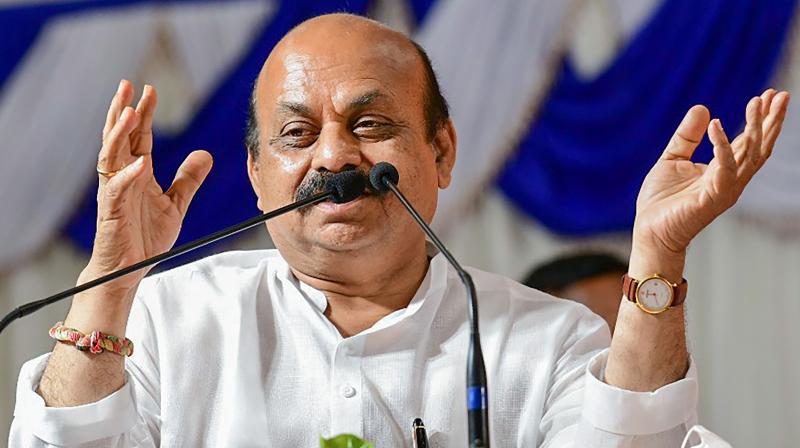
Between two fires: It’s obeying SC vs pacifying Hindus for Bommai now

The Basavaraj Bommai-led BJP government in Karnataka finds itself in a piquant situation following the Supreme Court-directed demolition of a temple on encroached land in Mysore district.
While on the one hand the Bommai-led BJP government is trying to stop more such demolitions, on the other hand, it cannot completely ignore a Supreme Court directive by putting a stop to the demolition.
In the interim, the government has issued oral instructions to district officials to temporarily halt all proposed demolitions of earmarked “places of worship” structures built on encroached public land.
Also read: Bengaluru is most linguistically diverse city in country: Study
The government has also issued show-cause notices to District Deputy Commissioner Dr Gautam Bagadi and Taluk Magistrate Mohan Kumari on the matter.
The local administration’s demolition of the Uchagani Mahadevamma temple in Nanjangud Taluk last week triggered outrage among the Hindu community, many among whom were BJP supporters. This led to the Bommai government being described as “anti-Hindu” by local party workers with its Mysuru-Kodagu Lok Sabha MP Pratap Simha too criticising the action.
The demolition was in line with a Supreme Court order which in 2009 had directed the removal of all places of worship irrespective of religion which had encroached on government land.
State Chief Secretary P Ravi Kumar on July 1, 2021, had instructed deputy commissioners to demolish all such illegal religious structures. The Mysore district administration had prepared a list of illegal structures of which 85 are temples, five mosques and one church.
Other temples listed for demolition include the Panchamukhi Ganapathi temple in Sayyaji Rao road, the 101 Ganapathi Temple in Agrahara, Durgaparameshwari Temple in Ittigegudu and Ramalimgeshwara Temple in Chamundipura.
The directive instructed officials to publicise the list and inform religious heads to clear the encroachments before the demolition drive.
In the case of the Uchagani temple, officials say it is just 12 years old. But temple priests claim it has been in existence since 500 years and that it was renovated 12 years ago.
The temple demolition using a JCB was supervised by Nanjanagud Taluk Magistrate and Tahsildar Mohan Kumari and her team. The temple is located 24 km from Nanjangud town on the HD Kote-Nanjangud state highway. The officials came with full police protection in the early hours of the local Gowri festival.
Mohan Kumari said 15 temples were identified as unauthorised in the taluk. Of these, two were demolished in 2010 itself. She claimed the Uchagani temple was constructed 12 years ago.
However, temple priest Mahadeva told this reporter that it was an ancient temple and that his great grandfather, grandfather, father and himself had worked there as priests. An emotional Mahadeva alleged that the temple had been demolished without prior intimation. He said the temple was renovated 12 years ago, but the old temple had existed for hundreds of years.
Prashanth a devotee in Uchagani village said officials should have informed villagers before demolishing the temple. He said the demolition had pained many people. “If they had informed earlier, we would have ourselves vacated the place,” he said adding that if the structure was obstructing traffic “we could have given alternative land for the road and saved the ancient temple”.
State archaeological department commissioner BR Poornima said the department dealt with the conservation of only officially-listed temples and monuments. She said the government also undertakes renovation of temples that come under the Muzarai and tourism departments.
District officials told The Federal that they merely followed orders sent for demolishing illegal religious structures across the state, and not those under the Archaeological Survey of India. They reiterated that the Uchagani temple was constructed 12 years ago on government land beside the state highway.
Meanwhile, in an attempt to steal a march over the ruling BJP, a self-espoused Hindutva champion, a slew of opposition leaders too have criticised the demolition. Former chief minister Siddaramaiah in a series of tweets condemned the demolition. He said the BJP government should have consulted local residents before taking such an action, ”which has hurt the religious sentiments of the people”.
Also read: Yediyurappa to tour Karnataka, add to BJP’s unease
The officials have not followed due process, he alleged. “Though there was a court order, the administration should have given a thought before implementing it,” he said.
The Congress leader demanded that a piece of land be earmarked to construct a temple there and compensate for the demolition.
Janata Dal (Secular) legislator GT Devegowda also condemned the demolition and said it had hurt the sentiments of Hindus.
According to officials, as of September 29, 2009, the number of illegal places of worship in Karnataka was 5,688. In the last 12 years, since the apex court order, the state has been able to demolish, relocate and regulate 2,887 of them.
The State Chief Secretary’s letter instructed district administrations and urban local body officials to prepare and execute a plan of action for the demolition of at least one illegal religious structure per taluk and per division every week.
The Dakshina Kannada district, with 1,579 illegal religious structures, has the highest number of unauthorised religious structures in public places, followed by Shivamogga (740), Belagavi (612), Kolar (397), Bagalkot (352), Dharwad (324), Mysuru (315) and Koppal (306), the letter stated.

